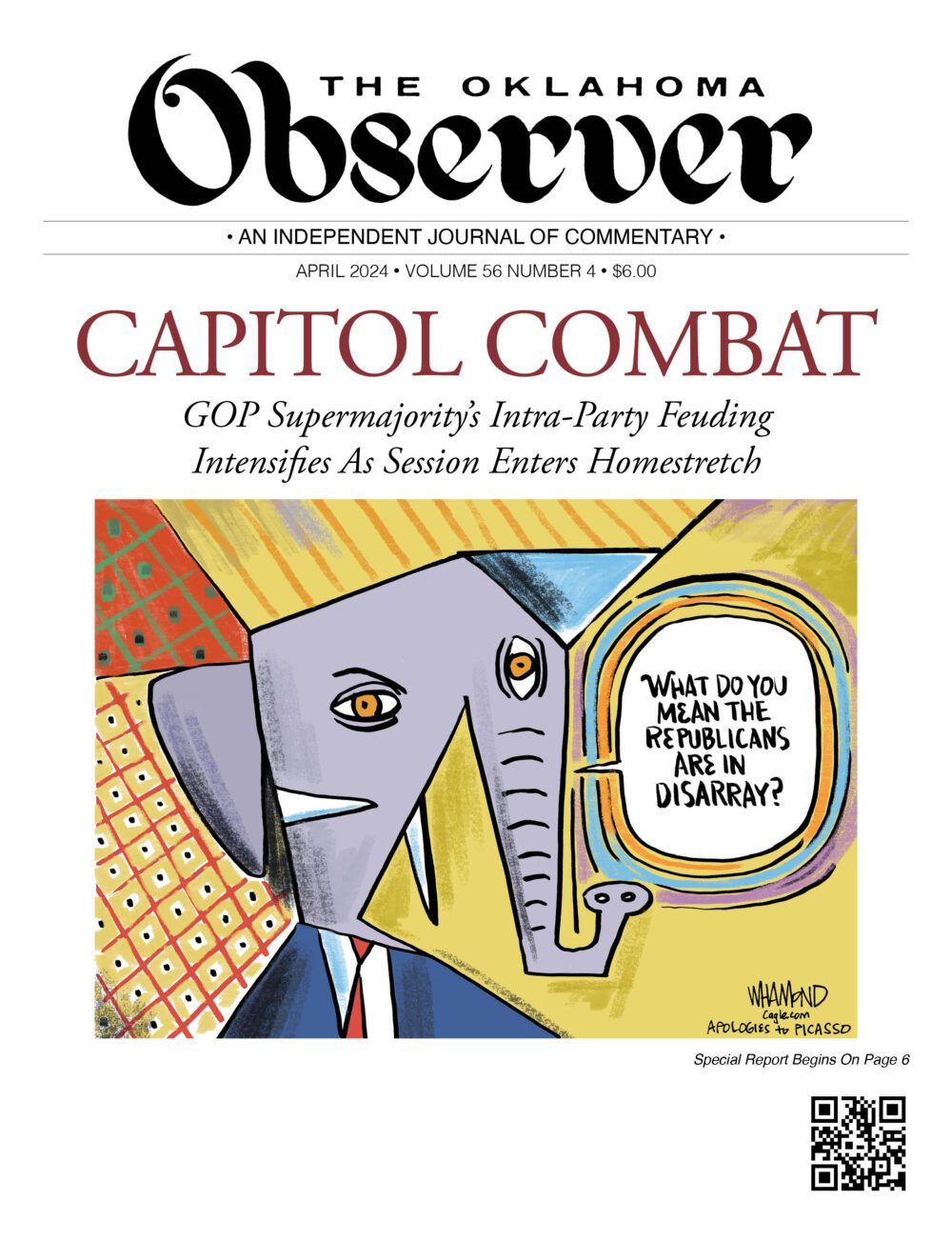BY JOHN WOOD
When I was on the Guthrie City Council in 2012, I led the charge to redistrict our small town because the population grew and our three wards shifted somewhat over the last 10 years. I found an OU political science doctoral student who possessed strong GIS skills hired to not only help state legislators draw lines, but also city and county officials.
The term “gerrymander” originates from the former 19thcentury Massachusetts Gov. Elbridge Gerry. His administration enacted an 1812 law defining unique state senatorial districts, thereby squeezing Federalist representation down to only a few voices. In effect, it threw the majority vote to the Democratic-Republicans. The most famous district from this time resembled a salamander, stretching across the state. A Boston Gazettecartoon at the time, dubbed it a “gerrymander.”
Today you can even find “Goofy Kicking Donald Duck,” since its shape resembles the Disney characters shaping Pennsylvania’s 7thDistrict. Interestingly, “Ugly Gerry” is a new typeface where each letter conspicuously resembles a gerrymandered congressional district hopefully bringing awareness to this issue.
As a political scientist, the process is fascinating, but it can make even the best of our eyes glaze over.
In Guthrie, I sat down with representatives from the three wards and we came up with three different maps. In the end, the council chose the map I recommended, which changed the lines the least. It was a positive experience, but I surmise it was only because council seats are nonpartisan in nature and we focused solely on balancing district populations within plus or minus 3%.
Partisan legislative and Congressional seats, however, are a different story.
In their book How Democracies Die, authors Steven Levitsky and Daniel Ziblatt argue that today the two parties represent “not just different policy approaches but different communities, cultures, and values” – exacerbated by reflexively partisan cable news and political gerrymandering.
Likewise, Norman Ornstein and Thomas Mann find that gerrymandering gives incumbents an unfair advantage: “Redistricting is a deeply political process, with incumbents actively seeking to minimize the risk to themselves [via bipartisan gerrymanders] or to gain additional seats for their party [via partisan gerrymanders].”
They find that gerrymandering ends up costing candidates more and increases partisanship as the districts become more polarized, perpetuating gridlock. Seats are also less competitive and tend to be less proportional. They achieve less descriptive representation, too, meaning winners of these districts do not look, act, or even think like the respective district’s average voter. Election winners are then determined more by incumbents who have too much of a hand in drawing them and less by the voters themselves.
And voters inherently know this to be true. A survey conducted by the Campaign Legal Center found that 71% of Americans would like the Supreme Court to define a standard that ends extreme partisan gerrymandering. Unfortunately, the court seems unwilling to do so at this time.
REPUBLICAN STRATEGIC DOMINATION
Currently, of the most gerrymandered districts in the United States, nine in 10 favor Republicans. What’s more, in districts where politicians perceive that nearly 80% of their constituents favor a certain political party, there is little incentive to compromise, driving an increasingly stagnant and dysfunctional Congress.
Salon’seditor-in-chief, Dan Daley, wrote a book called Rat F**cked: The True Story Behind the Secret Plan to Steal America’s Democracyin which he recounts an intriguing tale before the 2010 election. It’s about how GOP strategists and the Republican State Leadership Committee raised millions of dollars for the Redistricting Majority Project, REDMAP.
Gerrymandering means politicians listen to party leaders and pressure from outside interests, rather than the people. While the former Massachusetts governor gave gerrymandering its name, Thomas Hofeller is the architect who brought the process into the modern era.
Between redistricting cycles, Hofeller travelled nationwide. He presented PowerPoint presentations to prepare legislators for the next round of redistricting in 2010. Friends said he was known for the one-liners – or Hofellerisms – that hinted at privacy and discretion, at a time when the results of redistricting processes often ended up being challenged in court.
REDMAP strategically steered Hofeller on where to spend to bolster Republican candidates in Democratic-controlled state legislatures from North Carolina to Pennsylvania, Michigan to Wisconsin, according to Daley. The strategy was simply to flip control of the state’s legislative chamber, lock in redistricting, and thus control Congress for the next decade.
It worked, in the 2010 midterms, elections rode a “red wave” where the GOP captured 63 seats in the House of Representatives and 680 new seats in state legislatures across the country.
It was an effective strategy that the Democrats may have adopted had they thought it up first. As the 2020 elections roll around, expect a clash between the GOP’s REDMAP 2.0 led by former Wisconsin Gov. Scott Walker and the Democrat’s first attempt at BLUEMAP 1.0 to catch up, led by former Attorney General Eric Holder and Barack Obama who has made this a post-presidency focus.
While the REDMAP architect died in 2018, his legacy lives on. In May, a lawsuit over the 2020 Census citizenship question cited Hofeller’s analysis and other documents, saying “many striking similarities” existed between the unpublished Hofeller analysis and the Commerce Department’s decision to seek a citizenship question on the Census. While Donald Trump lost in the courts, he had indicated that he will find a way to add this question if he can. Hofeller’s legacy lives on.
It’s not just outcomes but intention. For instance, North Carolina’s Republican majority plan in 2016 included a criterion called “partisan advantage.” This led to what had been a largely purple state transitioning to distinctly red, with Republicans winning 10 of 13 – or 77% – of U.S. House seats while only garnering 53% of the vote share in the state.
One North Carolina Republican lawmaker actually made his intentions clear.
“I think electing Republicans is better than electing Democrats,” explained David Lewis, a member of the state General Assembly’s redistricting committee, “So I drew this map to help foster what I think is better for the country.”
He went on to say, “I propose that we draw the maps to give a partisan advantage to 10 Republicans and three Democrats, because I do not believe it’s possible to draw a map with 11 Republicans and two Democrats.”
WHAT CAN BE DONE?
Recently, courts explored multiple tests to deal with redistricting fairly.
In 2016, the Wisconsin Supreme Court, for example, decided on what they called the “efficiency gap.” It was a newly defined metric, created to appeal to the recently retired U.S. Supreme Court Justice Anthony Kennedy, who was in search of a convincing methodology to create district lines.
Simply put, the “efficiency gap” counts the number of votes each party wastes in an election to determine whether either party enjoyed a systematic advantage in turning votes into seats. In addition, any vote cast for a losing candidate is considered wasted, as are all the votes cast for a winning candidate in excess of the number needed to win.
In addition, an amicus curiaebrief filed by the Brennan Center for Justice in last year’s Gill v. Whitefordcase advocated for a “purpose-and-effects test,” which is a standard that “requires proof of both invidious intent and a partisan entrenching result that cannot be explained by neutral considerations.”
Unfortunately, the court ruled unanimously that the Wisconsin Democrats who sued failed to have standing because they hadn’t demonstrated that their own votes had been diluted because they were of the minority party.
In North Carolina the Legislature’s intentions seemed clearer: they had openly discriminated on the basis of partisan difference to draw line with a clear partisan advantage.
However, the recent Supreme Court’s most recent court cases show that the conservatives on the high court are not willing to define what constitutes partisan gerrymandering nor determine its legality, thereby permitting state legislatures to continue to redistrict with openly biased partisan intent. In June, the Supreme Court ruled 5-4 along ideological lines in a single court’s ruling on two consolidated cases – Rucho v. Common Causeand Lamone v. Benisek – stating that the issue of partisan gerrymandering is not judiciable; that is, it is a political issue and not something for the court to sort out.
Now it seems that federal courts are powerless to hear challenges to gerrymandering, “closing the door” to future challenges and leaving the matter solely in state legislative hands.
In a fiery dissent, Justice Elena Kagan penned: “The practices challenged in these cases imperil our system of government. Part of the court’s role in that system is to defend its foundations. None is more important than free and fair elections.
“Gerrymandering at its most extreme amounts to ‘rigging elections,’” Kagan said, quoting a 2004 opinion from now-retired Justice Kennedy. “The practice allows politicians to cherry-pick voters to ensure their re-election.”
The Supreme Court’s decision still allows cases of partisan gerrymandering to be tried in the lower courts, but it also may decrease lower courts’ willingness to hear those cases in the first place.
SOONER-STYLE GERRYMANDERING
In Oklahoma, there have been various efforts to change the redistricting process. During the 2019 legislative session, Rep. Regina Goodwin, D-Tulsa, failed to make much progress with her bill to create an independent redistricting commission. Her bill, like many authored by members of the minority party, was assigned to the House Rules Committee, which has a reputation for being “where bills go to die.”
David Blatt, outgoing executive director of the Oklahoma Policy Institute, surmised in a recent Journal Recordcolumn that there are murmurs of activists planning an initiative petition campaign for the November 2020 election. While certainly admirable, any such effort faces the daunting task of collecting more than 178,500 signatures from registered voters within a tiny 90-day window to make the ballot. What’s worse, that’s 54,000 signatures more now because of the high turnout for the last governor race.
I recently spoke with Rico Smith, a vocal Oklahoma Democrat who unsuccessfully attempted to organize a ballot initiative related to independent redistricting earlier this year.
“One of the foremost rights we have is the right to vote and petition our government,” he said. “If our voice can’t be respected by process, we don’t really have that right.”
Andy Moore, founder of the Oklahoma nonprofit Let’s Fix This, told me, “While Oklahoma is not as heavily gerrymandered as North Carolina, creating an independent redistricting commission would still be the right thing to do. If [the legislature] draws the lines, essentially, they are allowed to pick their own voters. The way lines are being drawn now, red districts get redder and blue districts get bluer – which means there are a lot of wasted votes.”
On the bright side, at the University of Central Oklahoma, I’m part of a study called: “One Person – One Vote: Addressing Gerrymandering in Oklahoma Through Policy and Mathematics.”
Overthe next year, a group of five faculty members in both math and political science, as well as student researchers in both disciplines, are working toward developing mathematical techniques to minimize bias in districting. As the political science expert, I will ensure these methods are informed by current and historical ideas on fairness as it relates to drawing lines and interpret their implications.
UCO’s group is motivated by the works of Tufts University Professor Moon Duchin, creator of the Metric Geometry and Gerrymandering Group, which focuses on applying cutting-edge mathematics to detect bias in districting with the goal of removing it as much as humanly possible.
Oklahoma, by the way, does have an ignored bipartisan redistricting commission available as a “backup” if lawmakers and the governor can’t agree on a plan.
With the current Republican supermajority, the Legislature and governor can bypass the commission and draw the lines without anyone’s input but theirs and to their specific advantage.
Part of Clean Missouri’s plan that garnered support from 63% of the state’s voters, creates a required independent redistricting commission among other reforms. We need this in Oklahoma, too – led by citizens who will not benefit in any way from partisan gerrymandering, allowing them to focus on fairness and transparency instead.
With the political preferences of fewer than half of Oklahoma’s population reflected in the state’s current districts, maybe a statewide petition or even applied geometry will make all of Oklahoma’s voices relevant again?
John Wood is an associate professor of political science at the University of Central Oklahoma. The views he expresses are his and not necessarily the university’s.
Editor’s Note: This essay first appeared in the September 2091 print edition of The Oklahoma Observer.








